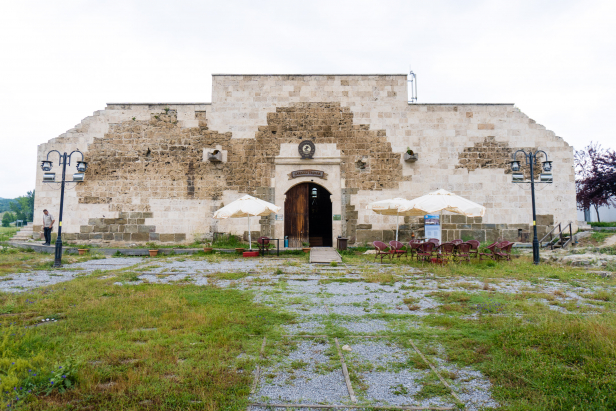Çakallı Taşhan Caravanserai
Çakallı Taşhan
/ By Josh
Cost: Free
(Free to look at but it is a restaurant and the food costs money)
Great for: Seljuk History, Silk Road, Caravanserai, Road tripping, Scrambled eggs
For thousands of years the valley where Çakallı Taşhan Caravanserai sits has been the gateway between the cities of Central Turkey and the port cities of the Black Sea. In the 13th century the Seljuk rulers of Central Turkey and much of the coastlands built a caravanserai to offer shelter to the caravans that travelled back and forth through these mountain passes.
Subscribe to The Art of Wayfaring
By the 13th century the Seljuks of Rum (Anatolia) had solidified their hold over what is now central Turkey and established their capital at Konya (ancient Iconium). With control of the territory came control of this portion of the Silk Road, a network of trade routes that passed from China and Persia through Anatolia to Constantinople and the cities of Europe. Controlling a trade route was lucrative, though it needed to be maintained and kept safe from thieves and raiders. The Seljuks’ solution was to build Caravanserai, or fortified inns of heavy stone, along the routes, spaced approximately one day apart as traveled by camel.

The Çakallı Taşhan was built to serve the caravans that connected the Black Sea port cities (as well as the many cities connected by the great trade rivers of the Dnieper and Danube) and into the land routes that ran like spokes from Konya. Çakallı Taşhan was the first stop from the city of Samsun.
The caravanserai was in a state of ruin before its restoration in 2013 and the main portal entrance, which would usually bear the inscription plaque, has been lost. Based on what is known of the history of the region and the design of the caravanserai, Çakallı Taşhan has been dated to the early 13th century and is believed to have been built by Seljuk Sultan Giyath al-din Kaykhusraw II (Giyaseddin Keyyhusrev II).
Çakallı Taşhan Caravanserai was built to a typical Seljuk design consisting of two major sections built along the same axis. In the front was a large open courtyard, surrounded by a vaulted portico and the entryway set in a large iwan. This section has not survived and only the foundations remain, giving us a sense of the scale of the place though the details of the Seljuk ornamentation are lost.
The second section is the large covered hall. The door to the hall at Çakallı Taşhan is simple compared to others though still built to a stately scale. The doorway was repaired by the Ottomans and again in 2013 and only a small portion of the Seljuk ornamentation remains in the darker stones of the lower courses. Inside the hall consists of three naves: a large central vault with a pair of smaller ones running parallel on either side. Unlike its more ornate cousins Çakallı Taşhan lacks a large cupola dome which would allow better airflow and light into the space. The masonry inside is a hodge-podge of massive blocks and small rubble-and-mortar construction. The door connecting the right side nave with the exterior is a relatively modern “addition” as Seljuk caravanserais would, as a rule, have one door to the exterior.

Today the Çakallı Caravanserai is being used as a restaurant serving the local dish, the Çakallı version of Menemen. Typically, menemen is made by frying chopped or grated tomatoes and green peppers with eggs in oil or heavy butter. Chili flakes and cheese are often added. The Çakallı take on this dish involves sauteing the tomatoes and pepper till they become smooth, then only the egg yolks are added and mixed as they fry. The result is a thick paste-like dish with a delicious pepper and tomato flavour. The Çakallı Menemen, like normal menemen, is then eaten with copious amounts of bread and numerous cups of tea.
Subscribe to The Art of Wayfaring
In the valley below Çakallı Taşhan there is a historic bridge. The original was built by the Seljuks though it was heavily repaired by the Ottomans. The result appears to be an entirely Ottoman construction of dark basalt stones forming a pair of twinned arches and a flat deck.
How To Get There
Car
Çakallı Taşhan sits just west (downhill) of the E95 (Samsun-Çorum) highway in the village of Çakallı. There is decent signage along the highway which will lead you off of the highway and to the caravanserai.
For more about car rental and driving in Turkey make sure to read our full drivers guide.
Public Transport
The road running through this valley is still the gateway between the Black Sea and the Turkish interior and there are many busses passing through here on their way to and from Samsun. The only issue is that the modern road is a little way above the ancient and you won’t be able to see the caravanserai when you pass by. However, if you get off at Mutlu Menemen or Menemenci Alaatin it’s only a 600 meter walk.
Where To Stay
Just as it was 800 years ago the village of Çakallı is still a stopover for travellers and there are some scattered hotels and bungalows in the hills above, set in the beautiful green hills of Samsun province. Otherwise the City of Samsun (34 kms), the Town of Merzifon (74 kms), and the City of Amasya (90kms) are all major centers with a decent selection of hotels. If you want to start your day with a Çakallı Menemen, then we recommend you spend the night nearby.
Other Tips
Planning on visiting Çakallı Taşhan Caravanserai? Make sure to check out what other sights are in the region!
Subscribe to The Art of Wayfaring
Have any tips or info to add? Spot any mistakes? We’d love to hear about it.
